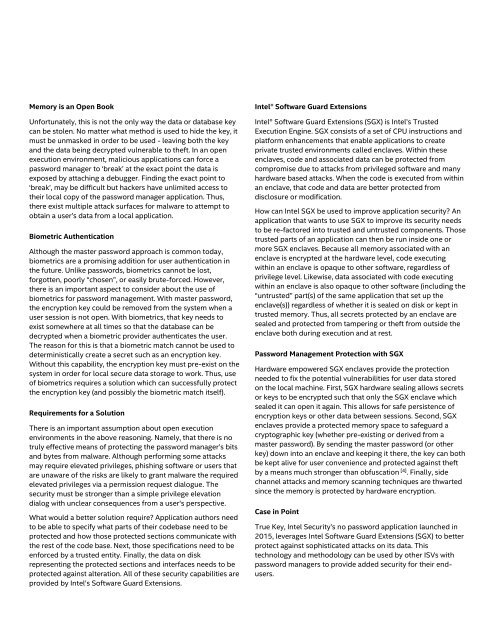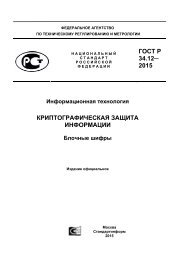Hardening Password Managers with Intel ® Software Guard Extensions
HardeningPasswordManagerswithSGX
HardeningPasswordManagerswithSGX
You also want an ePaper? Increase the reach of your titles
YUMPU automatically turns print PDFs into web optimized ePapers that Google loves.
Memory is an Open Book<br />
Unfortunately, this is not the only way the data or database key<br />
can be stolen. No matter what method is used to hide the key, it<br />
must be unmasked in order to be used - leaving both the key<br />
and the data being decrypted vulnerable to theft. In an open<br />
execution environment, malicious applications can force a<br />
password manager to ‘break’ at the exact point the data is<br />
exposed by attaching a debugger. Finding the exact point to<br />
‘break’, may be difficult but hackers have unlimited access to<br />
their local copy of the password manager application. Thus,<br />
there exist multiple attack surfaces for malware to attempt to<br />
obtain a user’s data from a local application.<br />
Biometric Authentication<br />
Although the master password approach is common today,<br />
biometrics are a promising addition for user authentication in<br />
the future. Unlike passwords, biometrics cannot be lost,<br />
forgotten, poorly “chosen”, or easily brute-forced. However,<br />
there is an important aspect to consider about the use of<br />
biometrics for password management. With master password,<br />
the encryption key could be removed from the system when a<br />
user session is not open. With biometrics, that key needs to<br />
exist somewhere at all times so that the database can be<br />
decrypted when a biometric provider authenticates the user.<br />
The reason for this is that a biometric match cannot be used to<br />
deterministically create a secret such as an encryption key.<br />
Without this capability, the encryption key must pre-exist on the<br />
system in order for local secure data storage to work. Thus, use<br />
of biometrics requires a solution which can successfully protect<br />
the encryption key (and possibly the biometric match itself).<br />
Requirements for a Solution<br />
There is an important assumption about open execution<br />
environments in the above reasoning. Namely, that there is no<br />
truly effective means of protecting the password manager’s bits<br />
and bytes from malware. Although performing some attacks<br />
may require elevated privileges, phishing software or users that<br />
are unaware of the risks are likely to grant malware the required<br />
elevated privileges via a permission request dialogue. The<br />
security must be stronger than a simple privilege elevation<br />
dialog <strong>with</strong> unclear consequences from a user’s perspective.<br />
What would a better solution require? Application authors need<br />
to be able to specify what parts of their codebase need to be<br />
protected and how those protected sections communicate <strong>with</strong><br />
the rest of the code base. Next, those specifications need to be<br />
enforced by a trusted entity. Finally, the data on disk<br />
representing the protected sections and interfaces needs to be<br />
protected against alteration. All of these security capabilities are<br />
provided by <strong>Intel</strong>’s <strong>Software</strong> <strong>Guard</strong> <strong>Extensions</strong>.<br />
<strong>Intel</strong><strong>®</strong> <strong>Software</strong> <strong>Guard</strong> <strong>Extensions</strong><br />
<strong>Intel</strong><strong>®</strong> <strong>Software</strong> <strong>Guard</strong> <strong>Extensions</strong> (SGX) is <strong>Intel</strong>’s Trusted<br />
Execution Engine. SGX consists of a set of CPU instructions and<br />
platform enhancements that enable applications to create<br />
private trusted environments called enclaves. Within these<br />
enclaves, code and associated data can be protected from<br />
compromise due to attacks from privileged software and many<br />
hardware based attacks. When the code is executed from <strong>with</strong>in<br />
an enclave, that code and data are better protected from<br />
disclosure or modification.<br />
How can <strong>Intel</strong> SGX be used to improve application security? An<br />
application that wants to use SGX to improve its security needs<br />
to be re-factored into trusted and untrusted components. Those<br />
trusted parts of an application can then be run inside one or<br />
more SGX enclaves. Because all memory associated <strong>with</strong> an<br />
enclave is encrypted at the hardware level, code executing<br />
<strong>with</strong>in an enclave is opaque to other software, regardless of<br />
privilege level. Likewise, data associated <strong>with</strong> code executing<br />
<strong>with</strong>in an enclave is also opaque to other software (including the<br />
“untrusted” part(s) of the same application that set up the<br />
enclave(s)) regardless of whether it is sealed on disk or kept in<br />
trusted memory. Thus, all secrets protected by an enclave are<br />
sealed and protected from tampering or theft from outside the<br />
enclave both during execution and at rest.<br />
<strong>Password</strong> Management Protection <strong>with</strong> SGX<br />
Hardware empowered SGX enclaves provide the protection<br />
needed to fix the potential vulnerabilities for user data stored<br />
on the local machine. First, SGX hardware sealing allows secrets<br />
or keys to be encrypted such that only the SGX enclave which<br />
sealed it can open it again. This allows for safe persistence of<br />
encryption keys or other data between sessions. Second, SGX<br />
enclaves provide a protected memory space to safeguard a<br />
cryptographic key (whether pre-existing or derived from a<br />
master password). By sending the master password (or other<br />
key) down into an enclave and keeping it there, the key can both<br />
be kept alive for user convenience and protected against theft<br />
by a means much stronger than obfuscation [4] . Finally, side<br />
channel attacks and memory scanning techniques are thwarted<br />
since the memory is protected by hardware encryption.<br />
Case in Point<br />
True Key, <strong>Intel</strong> Security’s no password application launched in<br />
2015, leverages <strong>Intel</strong> <strong>Software</strong> <strong>Guard</strong> <strong>Extensions</strong> (SGX) to better<br />
protect against sophisticated attacks on its data. This<br />
technology and methodology can be used by other ISVs <strong>with</strong><br />
password managers to provide added security for their endusers.





